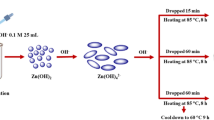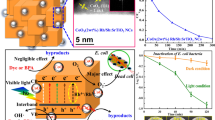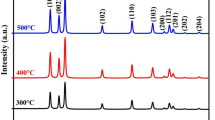Abstract
The utilization of visible light semiconductor photocatalyst was considered an effective technique to treat hazardous organic pollutants. From the focus of increasing the photocatalytic performance of zinc oxide, different concentrations of (5, 10, and 15%) strontium (Sr2+)-substituted ZnO hierarchical nanostructures were prepared by hydrothermal method. The sample characterizations were investigated by XRD, HR-SEM, photocurrent, EIS, and TOC analysis. The optical property of the samples was investigated by UV–visible diffuse reflectance spectra and photoluminescence (PL). The average crystalline size and strain (tensile strain) were calculated using the Williamson–Hall (W–H) plot. The hierarchical morphology of the sample was observed through SEM, and EDS confirms about the substitution of Sr. Occurrence of a peak at 142.7 eV in the XPS survey spectrum confirms the presence of Sr2+. Degradation of pollutant by 10% Sr–ZnO increases degradation efficiency from 44 to 97% with a time delay. The significant contribution of superoxide anions (•O2−) in degradation was obtained through scavenger analysis. TOC test confirms the decrement of organic carbon content. Reduction in electron–hole recombination was sufficiently attained because of the Sr atom, which functions as an electron transmitter. After degradation, the unchanged crystallinity nature of 10% Sr–ZnO reveals excellent stability and makes it a good candidate in environmental remediations.












Similar content being viewed by others
Data availability
The datasets used or analyzed during the current study are included in this published article.
References
Abdel-Shafy HI, Mansour MSM (2016) A review on polycyclic aromatic hydrocarbons: source, environmental impact, effect on human health and remediation. Egyp J Pet 25:107–123. https://doi.org/10.1016/j.ejpe.2015.03.011
Abdolahzadeh Ziabari A, Rozati SM (2012) Carrier transport and bandgap shift in n-type degenerate ZnO thin films: the effect of band edge nonparabolicity. Phys B Condens Matter 407:4512–4517. https://doi.org/10.1016/j.physb.2012.08.024
Abramovic B, Despotovic V, Šojic D, Fincur N (2015) Mechanism of clomazone photocatalytic degradation: hydroxyl radical, electron and hole scavengers. React Kinet Mech Catal 115:67–79. https://doi.org/10.1007/s11144-014-0814-z
Ahmad I, Ahmed E, Ahmad M, Akhtar MS, Basharat MA, Khan WQ, Ghauri MI, Ali A, Manzoor MF (2020) The investigation of hydrogen evolution using Ca doped ZnO catalysts under visible light illumination. Mater Sci Semicond Process 105:104748. https://doi.org/10.1016/j.mssp.2019.104748
Alves MM, Andrade SM, Grenho L, Fernandes MH, Santos C, Montemor MF (2019) Influence of apple phytochemicals in ZnO nanoparticles formation, photoluminescence and biocompatibility for biomedical applications. Mater Sci Eng C 101:76–87. https://doi.org/10.1016/j.msec.2019.03.084
An S, Joshi BN, Lee MW, Kim NY, Yoon SS (2014) Electrospun graphene-ZnO nanofiber mats for photocatalysis applications. Appl Surf Sci 294:24–28. https://doi.org/10.1016/j.apsusc.2013.12.159
Ashebir ME, Tesfamariam GM, Nigussie GY, Gebreab TW (2018) Structural, optical, and photocatalytic activities of Ag-doped and Mn-doped ZnO nanoparticles. J Nanomater 2018:9425938. https://doi.org/10.1155/2018/9425938
Chang J, Ahmad MZ, Wlodarski W, Waclawik ER (2013) Self-assembled 3D ZnO porous structures with exposed reactive 0001 facets and their enhanced gas sensitivity. Sensors 13:8445–8460. https://doi.org/10.3390/s130708445
De Voogt P, Janex-Habibi ML, Sacher F, Puijker L, Mons M (2009) Development of a common priority list of pharmaceuticals relevant for the water cycle. Water Sci Technol 59:39–46. https://doi.org/10.2166/wst.2009.764
Dhiman P, Kumar A, Shekh M, Sharma G, Rana G, Vo DVN, AlMasoud N, Naushad M, Othman ZA (2021) Robust magnetic ZnO-Fe2O3 Z-scheme hetereojunctions with in-built metal-redox for high performance photo-degradation of sulfamethoxazole and electrochemical dopamine detection. Environ Res 197:111074. https://doi.org/10.1016/j.envres.2021.111074
Dubury DF (2010) The photochemistry and photophysics of triphenylmethane dyes in solid and liquid media. Chem Rev 93:381–433. https://doi.org/10.1021/cr00017a018
Fares MM, Al-Rub FAA, Mohammad AR (2020) Ultimate eradication of the ciprofloxacin antibiotic from the ecosystem by nanohybrid GO/O-CNTs. ACS Omega 5:4457–4468. https://doi.org/10.1021/acsomega.9b03636
Giakoumaki AN, Kenanakis G, Klini A, Androulidaki M, Viskadourakis Z, Farsari M, Selimis A (2017) 3D micro-structured arrays of ZnΟ nanorods. Sci Rep 7:1–9. https://doi.org/10.1038/s41598-017-02231-z
Hayyan M, Hashim MA, Alnashef IM (2016) Superoxide ion: generation and chemical implications. Chem Rev 116:3029–3085. https://doi.org/10.1021/acs.chemrev.5b00407
Jiang SP (2019) Development of lanthanum strontium cobalt ferrite perovskite electrodes of solid oxide fuel cells—a review. Int J Hydrog Energy 44:7448–7493. https://doi.org/10.1016/j.ijhydene.2019.01.212
Johar MA, Afzal RA, Alazba AA, Manzoor U (2015) Photocatalysis and bandgap engineering using ZnO nanocomposites. Adv Mater Sci Eng 2015:934587. https://doi.org/10.1155/2015/934587
Khare P, Patel RK, Sharan S, Shankar R (2021) 8—Recent trends in advanced oxidation process for treatment of recalcitrant industrial effluents. In: Shah MP (ed) Advced oxidation processes for effluent treatment plants. Elsevier Inc., Amsterdam, pp 137–160. https://doi.org/10.1016/b978-0-12-821011-6.00008-6
Kiciński W, Dyjak S (2020) Transition metal impurities in carbon-based materials: pitfalls, artifacts and deleterious effects. Carbon 168:748–845. https://doi.org/10.1016/j.carbon.2020.06.004
Kumar A, Sharma SK, Sharma G, Guo C, Vo DVN, Iqbal J, Naushad M, Stadler FJ (2021) Silicate glass matrix@Cu2O/Cu2V2O7 p-n heterojunction for enhanced visible light photo-degradation of sulfamethoxazole: high charge separation and interfacial transfer. J Hazard Mater 402:123790. https://doi.org/10.1016/j.jhazmat.2020.123790
Li LH, Deng JC, Deng HR, Liu ZL, Xin L (2010) Synthesis and characterization of chitosan/ZnO nanoparticle composite membranes. Carbohydr Res 345:994–998. https://doi.org/10.1016/j.carres.2010.03.019
Li N, Du K, Liu G, Xie Y, Zhou G, Zhu J, Li F, Cheng HM (2013) Effects of oxygen vacancies on the electrochemical performance of tin oxide. J Mater Chem A 1(5):1536–1539. https://doi.org/10.1039/C2TA01012G
Li D, Huang JF, Cao LY, Li JY, OuYang HB, Yao CY (2014) Microwave hydrothermal synthesis of Sr2+ doped ZnO crystallites with enhanced photocatalytic properties. Ceram Inter 40:2647–2653. https://doi.org/10.1016/j.ceramint.2013.10.061
Li X, Yu J, Jaroniec M (2016) Hierarchical photocatalysts. Chem Soc Rev 45:2603–2636. https://doi.org/10.1039/c5cs00838g
Liang YC, Wang CC (2018) Surface crystal feature-dependent photoactivity of ZnO–ZnS composite rods via hydrothermal sulfidation. RSC Adv 8:5063–5070. https://doi.org/10.1039/c7ra13061a
Liu ZQ, Ding LX, Wang ZL, Mao YC, Xie SL, Zhang YM, Li GR, Tong YX (2012) ZnO/SnO2 hierarchical and flower-like nanostructures: facile synthesis, formation mechanism, and optical and magnetic properties. CrystEngComm 14:2289–2295. https://doi.org/10.1039/c2ce06296h
Lu Y, Yuan W (2018) Superhydrophobic three-dimensional porous ethyl cellulose absorbent with micro/nano-scale hierarchical structures for highly efficient removal of oily contaminants from water. Carbohy Polym 191:86–94. https://doi.org/10.1016/j.carbpol.2018.03.018
Lyngsie G, Krumina L, Tunlid A, Persson P (2018) Generation of hydroxyl radicals from reactions between a dimethoxyhydroquinone and iron oxide nanoparticles. Sci Rep 8:2–10. https://doi.org/10.1038/s41598-018-29075-5
Miao Y, Zhang H, Yuan S, Jiao Z, Zhu X (2016) Preparation of flower-like ZnO architectures assembled with nanosheets for enhanced photocatalytic activity. J Colloid Interface Sci 462:9–18. https://doi.org/10.1016/j.jcis.2015.09.064
Mufti N, Maryam S, Fibriyanti AA, Kurniawan R, Fuad A, Taufiq A, Sunaryono (2018) Morphological modification and analysis of ZnO nanorods and their optical properties and polarization. Scanning 2018:6545803. https://doi.org/10.1155/2018/6545803
Nagaraju G, Udayabhanu S, Prashanth SA, Shastri M, Yathish KV, Anupama C, Rangappa D (2017) Electrochemical heavy metal detection, photocatalytic, photoluminescence, biodiesel production and antibacterial activities of Ag–ZnO nanomaterial. Mater Res Bull 94:54–63. https://doi.org/10.1016/j.materresbull.2017.05.043
Neena D, Humayun M, Bhattacharyya D, Fu DJ (2020) Hierarchical Sr-ZnO/g-C3N4 heterojunction with enhanced photocatalytic activities. J Photochem Photobiol A Chem 396:112515. https://doi.org/10.1016/j.jphotochem.2020.112515
Ning X, Zhen W, Wu Y, Lu G (2018) Inhibition of CdS photocorrosion by Al2O3 shell for highly stable photocatalytic overall water splitting under visible light irradiation. Appl Catal B Environ 226:373–383. https://doi.org/10.1016/j.apcatb.2017.12.067
Ola O, Maroto-Valer MM (2015) Review of material design and reactor engineering on TiO2 photocatalysis for CO2 reduction. J Photochem Photobiol C 24:16–42. https://doi.org/10.1016/j.jphotochemrev.2015.06.001
Pascariu P, Tudose IV, Suchea M, Koudoumas E, Fifere N, Airinei A (2018) Preparation and characterization of Ni, Co doped ZnO nanoparticles for photocatalytic applications. Appl Surf Sci 448:481–488. https://doi.org/10.1016/j.apsusc.2018.04.124
Pradeev RK, Sadaiyandi K, Kennedy A, Thamizselvi R (2016) Structural, optical, photoluminescence and photocatalytic assessment of Sr-doped ZnO nanoparticles. Mater Chem Phys 183:24–36. https://doi.org/10.1016/j.matchemphys.2016.07.068
Putri NA, Fauzia V, Iwan S, Roza L, Umar AA, Budi S (2018) Mn-doping-induced photocatalytic activity enhancement of ZnO nanorods prepared on glass substrates. Appl Surf Sci 439:285–297. https://doi.org/10.1016/j.apsusc.2017.12.246
Qamar MA, Shahid S, Javed M, Iqbal S, Sher M, Akbar MB (2020) Highly efficient g-C3N4/Cr-ZnO nanocomposites with superior photocatalytic and antibacterial activity. J Photochem Photobiol A 401:112776. https://doi.org/10.1016/j.jphotochem.2020.112776
Qamar MA, Shahid S, Javed M, Iqbal S, Sher M, Bahadur A, Al-Anazy MM, Li D (2021) Designing of highly active g-C3N4/Ni-ZnO photocatalyst nanocomposite for the disinfection and degradation of the organic dye under sunlight radiations. Colloids Surf A Physicochem Eng 614:126176. https://doi.org/10.1016/j.colsurfa.2021.126176
Qiu R, Zhang D, Mo Y, Song L, Brewer E, Huang X, Xiong Y (2008) Photocatalytic activity of polymer-modified ZnO under visible light irradiation. J Hazard Mater 156:80–85. https://doi.org/10.1016/j.jhazmat.2007.11.114
Qiu J, Weng B, Zhao L, Chang C, Shi Z, Li X, Kim HK, Hwang YH (2014) Synthesis and characterization of flower-like bundles of ZnO nanosheets by a surfactant-free hydrothermal process. J Nanomater 2014:281461. https://doi.org/10.1155/2014/281461
Sayago I, Aleixandre M, Santos JP (2019) Development of Tin oxide-based nanosensors for electronic nose environmental applications. Biosensors 9:21. https://doi.org/10.3390/bios9010021
Sharma G, Pathania D, Naushad M, Kothiyal NC (2014a) Fabrication, characterization and antimicrobial activity of polyaniline Th(IV) tungstomolybdophosphate nanocomposite material: efficient removal of toxic metal ions from water. Chem Eng J 251:413–421. https://doi.org/10.1016/j.cej.2014.04.074
Sharma G, Naushad M, Pathania D, Mittal A, El-desoky GE (2014b) Modification of Hibiscus cannabinus fiber by graft copolymerization: application for dye removal. Desalin Water Treat 54:3114–3121. https://doi.org/10.1080/19443994.2014.904822
Sharma D, Patel RP, Zaidi STR, Sarker MMR, Lean QY, Ming LC (2017) Interplay of the quality of ciprofloxacin and antibiotic resistance in developing countries. Front Pharmacol 8:546. https://doi.org/10.3389/fphar.2017.00546
Sharma G, Kumar A, Sharma S, Naushad M, Dhiman P, Vo DVN, Stadler FJ (2020) Fe3O4/ZnO/Si3N4 nanocomposite based photocatalyst for the degradation of dyes from aqueous solution. Mater Lett 278:128359. https://doi.org/10.1016/j.matlet.2020.128359
Sharma G, Kumar A, Naushad M, Thakur B, Vo DVN, Gao B, Al-Kahtani AA, Stadler FJ (2021a) Adsorptional-photocatalytic removal of fast sulphon black dye by using chitin-cl-poly(itaconic acid-co-acrylamide)/zirconium tungstate nanocomposite hydrogel. J Hazard Mater 416:125714. https://doi.org/10.1016/j.jhazmat.2021.125714
Sharma SK, Gupta R, Sharma G, Vemula K, Koirala AR, Kaushik NK, Choi EH, Kim DY, Purohit LP, Singh BP (2021b) Photocatalytic performance of yttrium-doped CNT-ZnO nanoflowers synthesized from hydrothermal method. Mater Today Chem 20:100452. https://doi.org/10.1016/j.mtchem.2021.100452
Su Y, Hou L, Du C, Peng L, Guan K, Wang X (2012) Rapid synthesis of Zn2+ doped SnWO4 nanowires with the aim of exploring doping effects on highly enhanced visible photocatalytic activities. RSC Adv 2:6266–6273. https://doi.org/10.1039/c2ra20401k
Tama AM, Das S, Dutta S, Bhuyan MDI, Islam MN, Basith MA (2019) MoS2 nanosheet incorporated α-Fe2O3/ZnO nanocomposite with enhanced photocatalytic dye degradation and hydrogen production ability. RSC Adv 9:40357–40367. https://doi.org/10.1039/C9RA07526G
Tsang CHA, Kai L, Yuxuan Z, Wei Z, Tao Z, Yujie Z, Ruijie X, Dennis YCL, Huang H (2019) Titanium oxide based photocatalytic materials development and their role of in the air pollutants degradation: overview and forecast. Environ Inter 125:200–228. https://doi.org/10.1016/j.envint.2019.01.015
Tyona MD, Osuji RU, Lokhande CD, Ezema FI (2018) Photovoltaic properties of aluminum doped zinc oxide electrodes based on variation of aluminum impurities in the semiconductor. J Mater Phys Chem 6:9–16. https://doi.org/10.12691/jmpc-6-1-2
Wagener P, Faramarzi S, Schwenke A, Rosenfeld R, Barcikowski S (2011) Photoluminescent zinc oxide polymer nanocomposites fabricated using picosecond laser ablation in an organic solvent. Appl Surf Sci 257:7231–7237. https://doi.org/10.1016/j.apsusc.2011.03.097
Xia Y, Wang J, Chen R, Zhou D, Xiang L (2016) A review on the fabrication of hierarchical ZnO nanostructures for photocatalysis application. Curr Comput-Aided Drug Des 6:148. https://doi.org/10.3390/cryst6110148
Xiong J, Li W, Zhao K, Li W, Cheng G (2020) Engineered zinc oxide nanoaggregates for photocatalytic removal of ciprofloxacin with structure dependence. J Nanopart Res 22:155. https://doi.org/10.1007/s11051-020-04881-z
Xu X, Sun Y, Fan Z, Zhao D, Xiong S, Zhang B, Zhou S, Liu G (2018) Mechanisms for ·O2- and ·OH production on flowerlike BiVO4 photocatalysis based on electron spin resonance. Front Chem 6:64. https://doi.org/10.3389/fchem.2018.00064
Yang X, Liu H, Li T, Huang B, Hu W, Jiang Z, Chen J, Niu Q (2020) Preparation of flower-like ZnO@ZnS core-shell structure enhances photocatalytic hydrogen production. Int J Hydrog Energy 45:26967–26978. https://doi.org/10.1016/j.ijhydene.2020.07.027
Yarahmadi M, Maleki-Ghaleh H, Mehr ME, Dargahi Z, Rasouli F, Siadati MH (2021) Synthesis and characterization of Sr-doped ZnO nanoparticles for photocatalytic applications. J Alloys Compd 853:157000. https://doi.org/10.1016/j.jallcom.2020.157000
Ye Y, Feng Y, Bruning H, Yntema D, Rijnaarts HHM (2018) Photocatalytic degradation of metoprolol by TiO2 nanotube arrays and UV-LED: Effects of catalyst properties, operational parameters, commonly present water constituents, and photo-induced reactive species. Appl Catal B Environ 220:171–181. https://doi.org/10.1016/j.apcatb.2017.08.040
Zhang L, Mohamed HH, Dillert R, Bahnemann D (2012) Kinetics and mechanisms of charge transfer processes in photocatalytic systems: a review. J Photochem Photobiol C Photochem Rev 13:263–276. https://doi.org/10.1016/j.jphotochemrev.2012.07.002
Zhang N, Chen D, Niu F, Wang S, Qin L, Huang Y (2016) Enhanced visible light photocatalytic activity of Gd-doped BiFeO3 nanoparticles and mechanism insight. Sci Rep 6:26467. https://doi.org/10.1038/srep26467
Zheng Y, Zhu B, Chen H, You W, Jiang C, Yu J (2017) Hierarchical flower-like nickel(II) oxide microspheres with high adsorption capacity of Congo red in water. J Colloid Interface Sci 504:688–696. https://doi.org/10.1016/j.jcis.2017.06.014
Acknowledgements
Authors thankfully acknowledge the SRM Institute of science and technology (SRM IST), Department of Physics and Nanotechnology for the constant support to carry out this research work. Authors also gratefully acknowledge the Nanotechnology Research Center (NRC) for characterization facility.
Funding
The authors declare that they have no known competing financial interests or personal relationships that could have appeared to influence the work reported in this paper.
Author information
Authors and Affiliations
Contributions
RRC: conceptualization; investigation; methodology; software; writing—original draft. SB: conceptualization; methodology; data curation; software; validation. GB: conceptualization; supervision; validation; visualization; writing—review and editing. VG: methodology; validation; data curation. JA: validation; data curation. MN: data curation; validation; resources. All authors read and approved the final manuscript.
Corresponding author
Ethics declarations
Conflict of interest
All the authors declare that there is no competing interest in this research manuscript.
Ethics approval and consent to participate
Not applicable.
Additional information
Publisher's Note
Springer Nature remains neutral with regard to jurisdictional claims in published maps and institutional affiliations.
Rights and permissions
About this article
Cite this article
Chandrapal, R.R., Bharathkumar, S., Bakiyaraj, G. et al. Hydrothermally synthesized strontium-modified ZnO hierarchical nanostructured photocatalyst for second-generation fluoroquinolone degradation. Appl Nanosci 12, 1869–1884 (2022). https://doi.org/10.1007/s13204-022-02414-9
Received:
Accepted:
Published:
Issue Date:
DOI: https://doi.org/10.1007/s13204-022-02414-9




